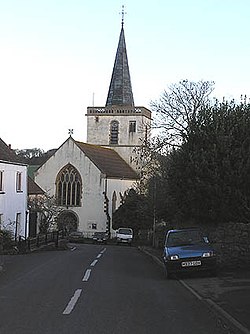Stogursey
| Stogursey | |
| Somerset | |
|---|---|
 Church of St Andrew, Stogursey | |
| Location | |
| Grid reference: | ST203430 |
| Location: | 51°10’51"N, 3°8’29"W |
| Data | |
| Population: | 1,385 (2011) |
| Post town: | Bridgwater |
| Postcode: | TA5 |
| Dialling code: | 01278 |
| Local Government | |
| Council: | Somerset West and Taunton |
| Parliamentary constituency: |
Tiverton and Minehead |
Stogursey is a small village in the Quantock Hills of Somerset, three miles from Nether Stowey, and eight miles west of Bridgwater. The village stands just inland of the Bristol Channel, which bounds the parish on the north, in Somerset's Cannington Hundred.
The parish includes the village of Stolford, which is believed to mean 'The stile ford' from the Old English stigol and ford,[1] and such hamlets as Burton, Knighton, Shurton, Stoford, Week, and Fairfield.

History
On the beach near Stogursey are the remains of a submerged forest dated to 2500 B.C.[2]
A Romano-British coin hoard was discovered in 1999. It contained 1,097 base silver radiates, the remains of a pottery vessel and 50 copper alloy coins.
The village takes its name from the manor of Stoke. Mediæval Stoche was in the possession of William de Falaise by 1086,[3] who had recently married Geva, daughter of Serlo de Burci, and widow of Martin "de Wallis". Early in the 12th century, William and Geva's daughter, Emma, was betrothed to William de Courcy, and the couple received the manor of Stoke upon their wedding. The manor was renamed Stoke Courcy, and is now known as Stogursey. Stogursey Castle was probably built in the 12th century.[4]
The best-known member of the family was John de Courcy, who made himself virtual Prince of Ulster after conquering it in 1177. He died about 1219, his descendants (through an illegitimate son) today being the Baron Kingsale of Ireland.
During the reign of King John (1199–1216), the manor became the property of one of his favourites and closest advisers, Fulke de Breauté of Gascony. Fulke's sister, Avice de Breauté, was mother of Sir Nicholas FitzMartin (c. 1210–82), who, like the de Courcys, was a descendant of Geva de Burci, the wife of William de Falaise, via her son Robert FitzMartin. Said to be tyrannical, Fulke made the castle and village a stronghold and den of robbers; he was eventually expelled in the reign of Henry III, and is said to have died in poverty in Normandy after 1224.
Part of a curtain wall from the castle remains incorporated into a cottage. It is a Grade II* listed building and Scheduled Ancient Monument.[5]
The remains of a Ham stone village cross on the High Street is from the Middle Ages. About thtree feet of the original shaft is still in the socket stone.[6][7]
In the Middle Ages Stogursey was an important place. It became a borough by 1225, and retained that status until at least 1833.[4]
A priory in the village was built by the Falaise family. To preserve the family's association with Normandy the priory was donated as a cell to the Benedictine Abbey of St Mary at Lonlay. This dwindled over the years and when all alien priories were appropriated by the crown in the 15th century Henry VI presented the endowments of Stogursey to "the College of the Blessed Mary of Eton beside Windsor" (Eton College), which he had founded a few years earlier.[8]
The ancient parish of Stogursey was large. It included the north foreshore of the Steart Peninsula, including Stert Island which broke from the mainland in about 1798. In 1885 Stert Island was transferred to the parish of Huntspill, and in 1933 the north side of the Steart Peninsula was transferred to the parish of Otterhampton.[4]
Wick Barrow, near Stogursey, is associated with pixies. It is said that a ploughman working nearby once mended a pixie's broken peel, and the pixie baked a cake to reward him.[9]
Haile Selassie, the emperor of Abyssinia, visited Stogursey in 1938.
Parish church

Within the village, at the bottom of the street, stands the Church of St Andrew.
The church was built early in the 12th century by William de Falaise, though believed to incorporate earlier features.[10] However, some of this native styling may be due to the workers' being English, not Norman. Also, in the 1940s the Reverend Basil Tucker removed much of the Victorian era work, giving the church its original, sparse yet pleasing shape.
About the village
Less than a quarter of a mile to the south of the village are the restored remains of Stogursey Castle.[5]
Outside links
| ("Wikimedia Commons" has material about Stogursey) |
- A History of the County of Somerset - Volume 6 pp 130-136: Stogursey (Victoria County History)
References
- ↑ Robinson, Stephen (1992). Somerset Place Names. Dovecote Press. ISBN 1-874336-03-2.
- ↑ A History of the County of Somerset - Volume 6 pp 130-136: Stogursey (Victoria County History)
- ↑ Stogursey in the Domesday Book
- ↑ 4.0 4.1 4.2 A History of the County of Somerset - Volume 6 pp 130-136: Stogursey (Victoria County History)
- ↑ 5.0 5.1 National Heritage List 1057403: Stogursey Castle (Grade II* listing)
- ↑ National Heritage List 1019034: Village cross north of St Andrew's Well (Scheduled ancient monument entry)
- ↑ National Heritage List 1345701: Remains of Village cross (Grade II* listing)
- ↑ Waite, Vincent (1964). Portrait of the Quantocks. London: Robert Hale. ISBN 0-7091-1158-4.
- ↑ Ash, Russell (1973). Folklore, Myths and Legends of Britain. Reader's Digest Association Limited. p. 165. ISBN 9780340165973.
- ↑ National Heritage List 1057404: Church of St Andrew (Grade I listing)